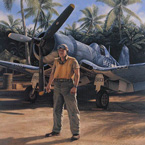Korvar
Posts: 813
Joined: 9/3/2014
Status: offline

|
It helps to differentiate between PBEM (human opponent) and single-player games against the AI.
PBEM is vastly more complex as playing against a human opponent introduces the full spectrum of game theory (as in the academic discipline) into the equation. "It depends" is the controlling phrase in this context. As an oversimplification, PBEM CAP strategy tends to be a "race to the top"; that is, fighters are often flown as high as possible and are often artificially restricted by house rules in an effort to help curb this tendency. It doesn't mean that multi-layered CAP doesn't have a place in PBEM - just that there is pressure to go higher due to the advantages given to those at higher altitude by the game engine. You'll often find yourself in a "paper, rock, scissors" situation where the enemy adopts strategy "A", so you counteract with strategy "B", which causes your opponent to react with "C", and so on.
Against the AI, things are more straightforward and tend to parallel historical practices better than PBEM. The first thing to recognize is that battle reports will tell you at what altitude(s) the attacking planes approached. You want to try to be above all attacking planes while still covering the altitude "bands" - that is, to not have an altitude differential so great that your CAP fighters are unable to react in time to stop approaching attackers. So:
1) Gain an altitude advantage wherever possible
2) Don't leave any gaps in coverage in terms of altitude
3) Everything is a compromise; try to stack the odds in your favor ahead of time, but realize that rarely will things be "perfect" - do the best you can with what you have
In the context of a carrier battle, you are typically defending against both dive bombers and torpedo bombers. Dive bombers must fly between 10,000 and 14,000ft in order to conduct a dive bombing attack (i.e. have the most accuracy). Torpedo bombers can approach at a similar altitude, but of course their primary attack is conducted at minimum altitude. So a default strategy could be to have CAP layers at 15k and 6k ft. The top CAP at 15k will cover the incoming dive bombers and the CAP at 6k will cover the torpedo bombers. What you don't want to do is to maximize CAP at one band and ignore the other. You could throw up your entire CAP let's say at ~17k to try to maximize the advantage attacking incoming dive bombers at 12k - but you're pretty much guaranteed to miss the vast majority of attackers under 10k, including (and especially) the torpedo bombers. The quickest way to be on the receiving end of a devastating attack is to allow enemy planes to approach completely unopposed (see my comments on disruption below).
It quickly becomes apparent that building a strong CAP in the context of carrier ops must be balanced against the escort provided to your own offensive air ops. It also becomes obvious why mutually supporting air bases (whether they are carriers or land bases) are such a powerful doctrine to abide by. Various fighter squadrons can be dedicated to either the defensive or offensive mission, and the types of aircraft can be allocated in such a way to take advantage of their strengths (high altitude fighters up high, lower altitude but perhaps more maneuverable fighters lower). Attacking aircraft can be concentrated at multiple altitude bands in such a way to saturate and overwhelm the enemy's CAP.
Don't forget that disrupting an enemy attack is the 1st order of business; destroying the attackers is a bonus. A bonus you should strive for, but not at the expense of disruption. Disruption is why the 5" and 40mm AAA guns are so useful even though you'll have fewer of them than the same ship loaded with .50cal, 20mm, and 1.1" guns. 5" and 40mm guns have a chance to disrupt the attack before it is successful whereas the others are deadliest when the enemy has already released their ordinance. Hence why the smaller AAA are referred to as "revenge weapons".
Finally, I'm not familiar with the "leaky CAP" strategy, but I'm sure somebody else here will be able to explain it.
|
 Printable Version
Printable Version
















 New Messages
New Messages No New Messages
No New Messages Hot Topic w/ New Messages
Hot Topic w/ New Messages Hot Topic w/o New Messages
Hot Topic w/o New Messages Locked w/ New Messages
Locked w/ New Messages Locked w/o New Messages
Locked w/o New Messages Post New Thread
Post New Thread